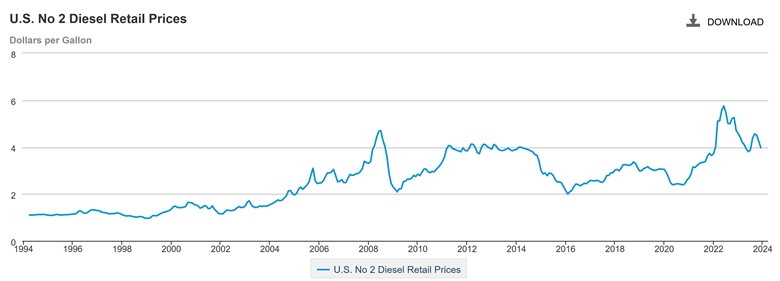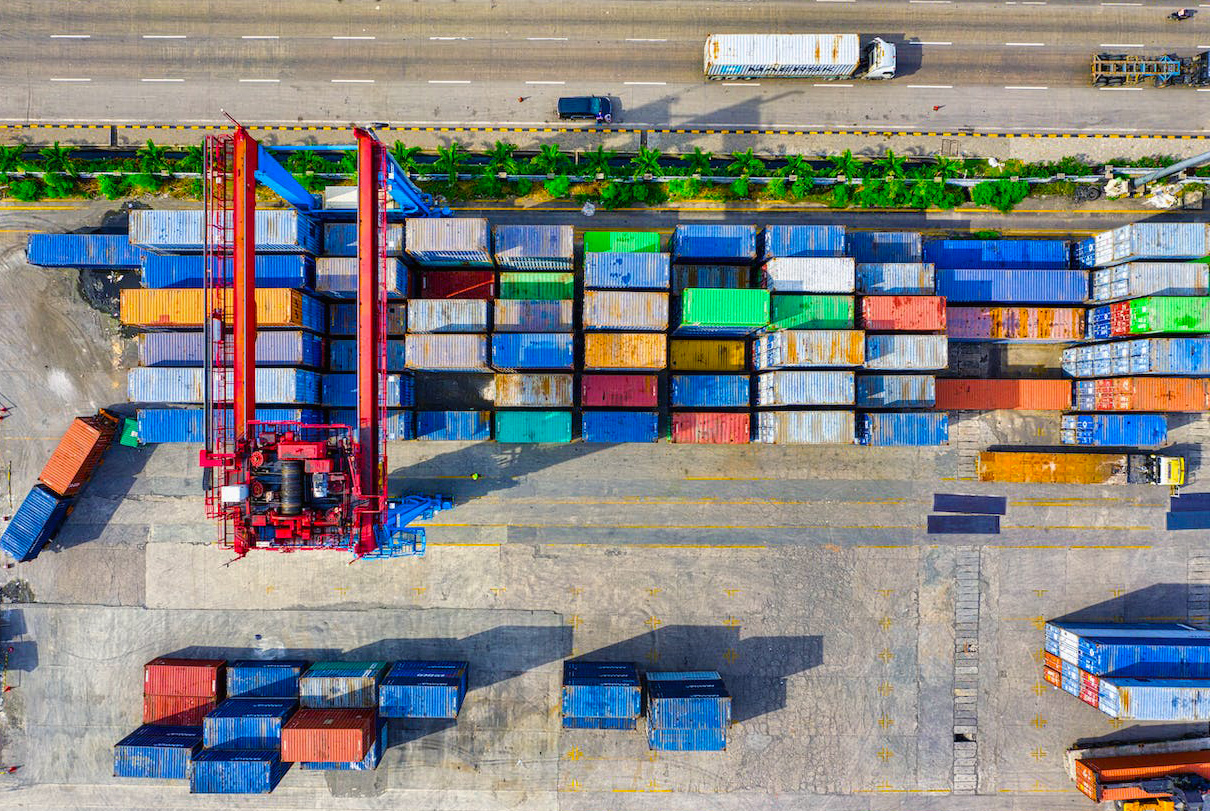Why Is Shipping So Expensive - 5 Reasons
Posted On 4th January 2024Trucking freight rates and trucking-related costs are much higher now than in pre-Covid times, and that combined with the physical reduction in freight capacity due to Covid was probably the most significant factor increasing global and national inflation according to a San Francisco Federal Reserve study:
Our analysis suggests that supply chain shocks can have significant impacts on PCE inflation by raising inflation expectations and intermediate input costs. We estimate that supply chain disruptions contributed on average about 60% of the run-up of U.S. inflation during the past two years.
Shipping is “so expensive” for many reasons. In the US, average Fuel price and its volatility rate have gone up along with insurance, labor, a contraction in trucks produced, increased new and used truck prices, increased trucker startup costs, increased red tape, and stricter driver hours enforcement via EDL (electronic data logs) in every truck – those root causes have combined to cause second-order effects on the market such as insurance market breakdown, delays at DMF and other red tape issues, fewer drivers on the road which seemed to be greater than the reduction in demand for trucking services, all of which led to third-order effects such as increases in both spot and contract pricing (which are also self-reinforcing trends), and then large spike in fraud truckers and brokers attempting to take advantage of the Demand sides desperation due to the shrunk capacity which led to increase in costs for shippers and their intermediaries.
It is always easy to point to the latest spike in fuel prices, but truckers are an outsize vocal group, and then the price of diesel falls they are silent on the issue. Despite that – the average price of diesel is definitely since 2004 on a long-term increase. Still, as you can see from the below graph, but might not know, between 2009 and 2021 there wasn’t much reason to complain about the diesel price being too high however, truckers still complained nearly daily that the price of diesel was “too high.”

Source of the above: US Energy Information System: https://www.eia.gov/dnav/pet/hist/LeafHandler.ashx?n=pet&s=emd_epd2d_pte_nus_dpg&f=m
The problem with fuel costs is that when fuel is low it is 20% of operating costs but when high it is 37% even 40% sometimes higher of operating costs. Contract carriers usually protect themselves by quoting an annual price and then a separate fuel surcharge which varies with the regional or national spot price fuel index announced by the government. That may work for their front haul – but on their back haul even they are dependent on what the Spot Market will pay them. Carriers operating in the Spot Market completely are even more effected by spikes in fuel costs, the rates are typically booked “all-in” and may or may not increase enough to cover the increased costs in fuel – mostly not. Rates did go up in the Spot Market, but Carriers said by not enough to cover the increased costs of fuel. There is no doubt that in sudden and violent fuel increase periods such as in March of 2022 when fuel was $5.25 on average nationwide, double what it was in Jan of 2021, truckers get hurt as freight rates are generally “stickier” than fuel rates ie they are slower to adjust.
In addition, violent price increases or decreases – volatility in other words – has increased in general and this leads to Carriers adding a “volatility cushion” estimate on top of their operating expenses and to them demanding higher rates per mile. So on top of an absolute fuel price there is a volatility premium during times of increased volatility which certainly the last decade has had vs. the previous decade.
In fact, in-depth research found that contract rates grew 25 to 50% higher within a one-year period. But there’s more to why current freight rates are skyrocketing.
What is the Current Freight Rates per Mile in 2025?

Research by DAT shows that the average van freight rates are $2.10 per mile, indicating a $0.2 increase, whereas the loads-to-truck ratio reached 1.72 compared to 2.12 in November.
Moreover, the study found that reefer freight rates hit a whopping $2.41 per mile, showcasing a $0.8 increase from the previous month. In addition, the reefer capacity for loads averages 1.88 compared to 3.16 in November.
Furthermore, the fuel prices reached $3.89 a gallon, compared to the $4.29 charge, making truckers wonder why shipping costs are so high! Remember that the exact cost for reefer, flatbed, and van freight can vary depending on dimensional weight and zip codes.
So, Why Are Shipping Costs So High?
If you’ve been wondering ‘why is shipping so expensive,’ we’re here to answer! Let’s unpack the top five reasons causing an increase in shipping services’ expenses:
The Global Shipping Container and Labor Shortage
One cause behind the more expensive supply chain was the decreasing exports from China, as that nation’s inability to export due to its draconian COVID rules led to not enough labor at the ocean ports and at the cargo airports there. The steamship lines (Maersk, MSC, etc) were able to dramatically increase rates for any containers they were able to get out. This completely disrupted the global supply chain and also the US ports unloaded ships extremely slowly leading to huge unloading delays and long lines of unloaded ships waiting outside all the major ports but mostly the West Coast USA ones.
An effect of both labor shortages and parts shortages in coming to USA truck factories was that truck manufacturers for a few years were only able to produce about 80,000 trucks per year, well short of the 250,000 needed to replace aging fleets. That led to spikes in the prices of used trucks, and also to a generally less efficient fleet servicing the existing volume of freight being moved within the USA, so a fleet that had to be repaired more often and that burned more fuel than it otherwise would have, inflating carrier costs further and putting carriers out of business and the survivors dramatically trying to raise prices.
Overall, this meant fewer trucks on the road, the trucks that were on the road were less efficient, and the delivery times also went up substantially; further disrupting the supply chains in an Unvirtuous Cycle. Again, the costs per mile for freight trucking rates were higher than they would have been with normal rotation into newer trucks. Another consequence of both Covid, truckers closing doors, and longer wait times at ports and warehouses was drivers either quitting or being taken out of the market; so a labor shortage, which then skyrocketed driver pays, increasing carriers’ costs, putting further pressure on freight rates to go up.
The Increase in Insurance Costs
Insurance costs in the trucking industry are also out of control. It is quite a broken system, with some drivers paying $30,000/year for their one tractor and trailer, and others $5,000! Believe it or not, it is not necessarily because the $30,000 guy poses more risk . It is a frustrating and huge problem facing carriers, especially smaller carriers, who face significant increases every year and already very high absolute costs. Newer truckers are often finding these costs impossible to make up by any means, and simply do not open their doors.
The Surge in the Spot Market
Another cause of freight increases, related to capacity, is the inability to quickly put new trucks to work due to longer registration times at the DMV, due to fewer workers and appointment-only DMVs, coupled with crazystartup insurance costs for new truckers, and complicated cross-state regulations that are harder and harder to keep track of, all of which make it almost impossible for the smaller truck operation to get started or to even stay in business.
Usually, when the spot market prices would surge in the USA it would quickly lead larger Carrier operators to add trucks and drivers and new startup truckers to get started – that due to bureaucracy and red tape, raised interest rates which make it more difficult to get started in business, and the huge extra premium insurance companies charge startup trucking operations make it nearly impossible for the supply side of trucking to quickly adjust to higher rates by adding more capacity. The small, independent trucker is really at a disadvantage in this insurance market, and thus in the trucking industry.
The Economic Uncertainty and Instability
Also the economic uncertainty and general level of instability and pessimism in the US leads to lower investment and a lower number of startup trucking firms. With a highly fluctuating macroeconomic environment, the price of fuel fluctuates widely, and trucking companies naturally calculate that their average price of fuel will be significantly higher very soon.
There is a volatility premium added to today’s price because we assume the price will get worse tomorrow or next month. This volatility and inflation expectation can become a self-fulfilling prophecy and, in any case, is a negative loop in the freight industry. This again reduces the will to invest further in the industry, to add more capacity.
The Increase in Interest Rates
We talked about interest rates, but they also had another effect in that the cost of trucks and trailers the cost of borrowing to have them had doubled, and this means the carriers must charge more money per mile to re-coop the money lost to interest payments and cut back on having any excess capacity.
When Will Freight Rates Go Down?
Many trucking companies are wondering why the freight market rates are skyrocketing. According to a recent freight rate forecast, ocean rates will experience a downward trajectory in 2024 and the aftereffects could linger in 2025.

In addition, trucking companies have low expectations for freight orders, providing a trend of freight rates dropping substantially. If you’re wondering ‘why are trucking rates so low’ and ‘when will freight rates go up’ logistics executives state that the rates may drop by 33% to 80%, depending on area.
Thus, you won’t have to worry about when trucking rates will go up for a while!
The Bottom Line
For all these reasons, the freight market has experienced significant inflation, causing shipping expenses to hit the sky and making trucking companies question ‘Why is freight shipping so expensive.’ On the bright side, we expect the current freight market to move downward.
Thus, it’s likely that freight rates for trucking, flatbed, and reefer will reduce in 2025.




